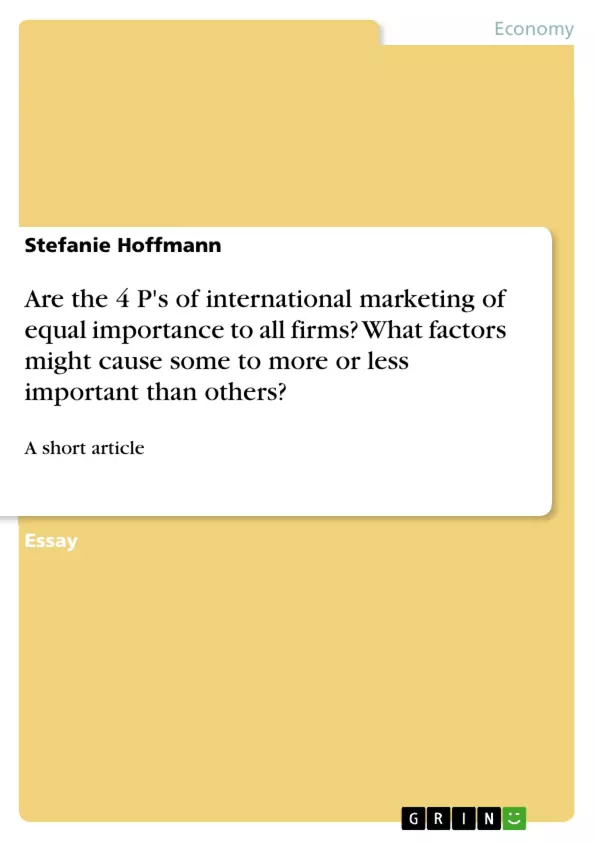Are the 4 P´s of international marketing of equal importance to all firms? What factors might cause some to be more or less important than others? by Stefanie Hoffmann Nowadays marketing should be an indispensable part of all companies. Therefore many organisations and companies have marketing departments made up of marketing managers and specialists who have to coordinate the different areas of the marketing mix. Marketing has to be understood as a concept which stands at the beginning of the production process and which has to be integrated in all company areas. It describes the exact organisation, planning, execution and control of all company activities which should help to define customers´ wishes and expectations. (Lecture, Tourism Marketing, Bentele, Dr. B., Merkur Academy, 2004/2005) Nevertheless it is difficult to find an exact definition of marketing. Often it means different things to different people. As we are living in a fast-moving society, situations develop and change. The accepted UK definition is the one given by the Chartered Institute of Marketing: “Marketing is the management process which identifies, anticipates, and supplies customer requirements efficiently and profitably.” (Lancaster and Massingham, 1999, p. 4)
In general, marketing is divided into strategic and operative marketing. In principle, the strategic marketing deals with the aims of the company, for example which competitors should be observed which markets are important or which target groups should be served with which products. The chosen strategies describe the way in which the company wants to reach their focused aims. The operative marketing deals with the planning and execution of these strategies. With this aim in view, the company combines different marketing instruments which are known as the marketing mix. The most important marketing instruments are product, price, place and promotion, also known as the 4 P´s. This notion of the marketing mix is attributed to Neil H. Borden (1965) and refers to the set of marketing ingredients a company can use to achieve its objectives. (Lancaster and Massingham, 1995) [...]
Inhaltsverzeichnis (Table of Contents)
- Product
- Product Mix
- Product Policy in the Narrow Sense
- Price
- Pricing Strategies
- Condition Policy
- Place
- Promotion
- Advertising
- Sales Promotion
- Personal Selling
- Public Relations (PR)
Zielsetzung und Themenschwerpunkte (Objectives and Key Themes)
This text explores the importance of the four P's of marketing (product, price, place, and promotion) in the context of international business. It investigates whether these elements hold equal weight for all companies and examines the factors that might influence their relative importance.
- The significance of the marketing mix in international business
- The relative importance of each element of the marketing mix (product, price, place, and promotion)
- Factors influencing the strategic importance of different marketing elements
- The application of marketing strategies in different international contexts
- The role of customer needs and expectations in shaping international marketing strategies
Zusammenfassung der Kapitel (Chapter Summaries)
The text delves into each of the four Ps, starting with the product. It discusses the product mix, which includes factors such as the number of product lines and variations, and the product policy in the narrow sense, which encompasses elements like design, branding, packaging, and service policy. The importance of developing a unique selling proposition (USP) to differentiate from competitors is emphasized.
Next, the text examines pricing, focusing on pricing strategies such as skimming and penetration. It also discusses factors influencing pricing decisions, including demand, costs, competitors, and substitute products. The importance of condition policy, which encompasses credit conditions, discounts, and terms of payment and delivery, is also highlighted.
The concept of "place" in the marketing mix is explored, emphasizing the role of distribution channels in delivering products to customers. The text contrasts direct distribution with selling through intermediaries and discusses the advantages and disadvantages of each approach. The factors influencing the choice of a distribution channel are also examined.
Finally, the text focuses on promotion, explaining its role in communicating product benefits to target markets. Different promotional methods are discussed, including advertising, sales promotion, personal selling, and public relations. The importance of a promotional mix tailored to the specific product, consumer expectations, and company philosophy is emphasized.
Schlüsselwörter (Keywords)
The text focuses on key concepts such as international marketing, marketing mix, product, price, place, promotion, distribution channels, pricing strategies, target markets, customer needs, and consumer expectations. It delves into the application of these concepts in international business and examines the factors influencing their strategic importance.
- Quote paper
- Stefanie Hoffmann (Author), 2005, Are the 4 P's of international marketing of equal importance to all firms? What factors might cause some to more or less important than others?, Munich, GRIN Verlag, https://www.grin.com/document/55109



